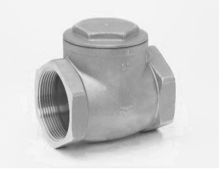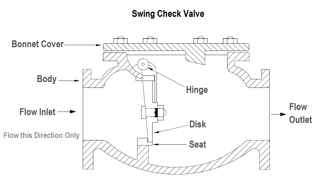Check valves can be used in a variety of applications ranging from pipelines to gas export facilities.
 A check valve is also known as a clack valve, one-way valve, or non-return valve as it allows fluid to flow in one direction only. These industrial valves are automatically activated by the force produced by the flow of the medium itself through the pipeline and can be classified as an automatic valve. The check valves are being used in pipeline systems, their key functions are to prevent the medium from flowing back, to prevent the pump and its generator from reversing, and to prevent the medium from flowing back from the container. The check valve may also be used to substitute the auxiliary system at which pressure can increase above the pressure of the main system. If the flow reverse and no check valve is fitted, water hammer can take place. Water hammer often occurs with excessive force and can easily damage the pipeline or parts.
A check valve is also known as a clack valve, one-way valve, or non-return valve as it allows fluid to flow in one direction only. These industrial valves are automatically activated by the force produced by the flow of the medium itself through the pipeline and can be classified as an automatic valve. The check valves are being used in pipeline systems, their key functions are to prevent the medium from flowing back, to prevent the pump and its generator from reversing, and to prevent the medium from flowing back from the container. The check valve may also be used to substitute the auxiliary system at which pressure can increase above the pressure of the main system. If the flow reverse and no check valve is fitted, water hammer can take place. Water hammer often occurs with excessive force and can easily damage the pipeline or parts.
 Swing check valve: The basic swing check valve comprises the body of the valve, the cap, and the disc that is attached to the hinge. The disc swings away from the valve seat to make forward flow and goes back to the valve-seat when the flow is stopped to prevent backflow. The disc in the swing check valve is not guided as it fully opens or closes. There are many discs and seat designs available to fulfil the standards of different applications. The valve provides seamless, unobstructed flow and closes automatically as the pressure decreases. These valves are completely closed when the flow is zero, to prevent backflow.
Swing check valve: The basic swing check valve comprises the body of the valve, the cap, and the disc that is attached to the hinge. The disc swings away from the valve seat to make forward flow and goes back to the valve-seat when the flow is stopped to prevent backflow. The disc in the swing check valve is not guided as it fully opens or closes. There are many discs and seat designs available to fulfil the standards of different applications. The valve provides seamless, unobstructed flow and closes automatically as the pressure decreases. These valves are completely closed when the flow is zero, to prevent backflow.
A few of the check valves are specially designed to stop their disc or flap under certain conditions, such as reversing the flow. This abrupt closing or slamming creates a fluid pressure wave that pulsates throughout the system and, depending on the specific application, can ultimately lead to lower process efficiency, valve damage, gasketed joint leakage and other problems. This unavoidable — but controllable — phenomenon is referred to as a water hammer. Non slam check valves are specifically designed for use in these situations. As the name suggests, these valves close without slamming, which means that no excess pressure spikes are created. The disc of the non-slam check valve has an inbuilt spring that is opposition to the flow pressure of the opening fluid. When the flow of the fluid is strong enough, the spring compresses and the valve opens up; the disc is gently pushed back to the seating surface of the valve by the spring as the flow decreases and stops, but before the direction of flow reverses.
Dual plate check valves are supplied as standard with a retractable valve. Our patented design has no threaded plugs in the pressure boundary and completely eliminates the potential leakage to the atmosphere. This design is designed to meet the fugitive emission control. Dual plate Check Valve is cost effective for construction and repair as less and light weight is required for installation. Dual plate Check Valve is possible to avoid the hammering of water due to the closing of the valve disc by operating the spring in the valve well before backflow. The average lifespan is longer than the existing Check Valve, and maintenance and repair is simple.
All the check valves are ideal for use in a variety of applications like Gas and liquid pipelines, water and steam systems, cooling towers, water treatment, gas export facilities, product tank farms, gas storages, Mine dewatering.
Generally, non-slam check valves are suitable for vertical tubing or complex applications requiring constant and manageable pressure levels. Alternatively, swing check valves have been used in very large-volume applications, horizontal pipe runs, and applications where there is no concern for varying pressures and flow rates.
Due to the precise pressure demands, non-slam check valves are commonly specified in various oil and gas, refining, and power industry processes. Non-slam check valves are used in related applications in the chemical manufacturing sector, through steam condensate systems, and throughout the power generation sector.
Swing check valves, due to their less controlled closed and open mechanics, would be used in less critical applications. They are most commonly used in large-scale piping applications, such as liquid, gas, and steam, normally only in horizontal configurations. In general, they are often used in natural gas systems, as the processing of natural gas usually does not require as strict a control of pressure as the oil and refining sector or in sewage and water treatment facilities.
NTGD offers a variety of check valves specially made for use in a wide range of applications across all industries. For more information mail us at sales@ntgd.co.uk.
In this episode, I sat down with Beejan Giga, Director | Partner and Caleb Emerson, Senior Results Manager at Carpedia International. We discussed the insights behind their recent Industry Today article, “Thinking Three Moves Ahead” and together we explored how manufacturers can plan more strategically, align with their suppliers, and build the operational discipline needed to support intentional, sustainable growth. It was a conversation packed with practical perspectives on navigating a fast-changing industry landscape.